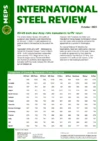US Steel left with limited options if Nippon bid fails
The planned acquisition of US Steel by Japan’s Nippon Steel is at risk after reports that President Biden is expected to block the deal based upon national security concerns.
The USD14.9 billion deal has been in limbo since the initial acquisition announcement on December 18, 2023. Several US lawmakers, including President Biden, are opposed to the plan and the USW union have long expressed their opposition to it.
The Committee on Foreign Investment in the United States (CFIUS), a body responsible for evaluating the national security implications of foreign investments, has been investigating the proposed takeover. Upon receiving its recommendations, which are not made public, President Biden will have 15 days to decide whether the Nippon takeover will be permitted or blocked.
Laura Hodges, MEPS International's US steel market consultant, said that two options would likely remain for US Steel, if Nippon's acquisition was ultimately blocked.
"Cleveland-Cliffs has gone on record multiple times that they are still interested in acquiring US Steel, but they would need to re-evaluate their bid," she said. "They previously offered USD35 per share, but the Nippon deal was worth USD55 per share. Last week, Cliffs publicly offered to buy the unionised assets of US Steel and mentioned that they already have financing in place.”
Antitrust concerns could stall a Cleveland-Cliffs takeover of the entire US Steel business. It has been estimated that such a deal would place 65% to 90% of steel used by US carmakers under the control of a single company.
Hodges said that if the Nippon takeover was blocked, and a successful bid by Cliffs not forthcoming, then “US Steel may be left with little choice but to close facilities, unless government funding was made available”. She said: “Some of the business's older, more traditional steelmaking sites require investment and that is something that Nippon would have brought to the table."
Third-largest steelmaker in the US
Most of US Steel’s recent investment has been focused on its minimill operation at the Big River Steel (BRS) facility in Arkansas. US Steel purchased the remaining portion of BRS in 2021. The current BRS capacity of 3.3 million tonnes will double in the near term due to the construction of the BRS2 EAF plant, which is expected online by the end of 2024.
US Steel is currently the third-largest steel producer in the United States – behind Nucor and Cleveland-Cliffs – and 27th in worldsteel’s tonnage ranking. The raw steel facilities at US Steel are divided into four components – integrated, minimills, European operations and tubular. According to US Steel’s 2023 annual report, last year’s capacity and utilisation rates were: integrated mills (13.2m tonnes, 71%); minimills (3.3m tonnes, 89%); European operations (5m tonnes, 88%); and tubular (900,000 tonnes, 63%). In 2013, the total capacity of North America’s integrated mills was 24.3m tonnes.
Closures at US Steel – the country's third-largest producer by volume – would potentially reduce the US's steelmaking capacity at a time that sees new legislation being introduced to discourage the purchase of imports, in favour of domestically produced material.
US government bids to boost the domestic steel industry
President Biden recently increased the Section 301 tariff rate on steel from 7.5% to 25%, although that tariff rate has yet to be implemented pending further review. Additionally, the US government’s Infrastructure Investment and Jobs Act (IIJA) stipulates that domestic steel must be used by projects seeking funding. While it has been almost three years since the IIJA was passed, the funding has been slower than expected. Nonetheless, US steel mills expect an uptick in demand from IIJA-backed projects in 2025.
MEPS's market research shows that steel demand in the US has been subdued. The steel market analyst’s benchmark hot rolled coil price, in August’s International Steel Review, was at its lowest level since December 2022.
MEPS’s US research partners say that uncertainty has been a key reason for the low levels of demand. Buyers are uncertain about the upcoming US presidential election, the timing and influence of US Federal Reserve interest rate cuts and the future of a key steel supplier in the United States.

Source:
International Steel Review
The MEPS International Steel Review is an essential monthly publication, offering professional analysis and insight into carbon steel prices around the world.
Go to productRequest a free publication





